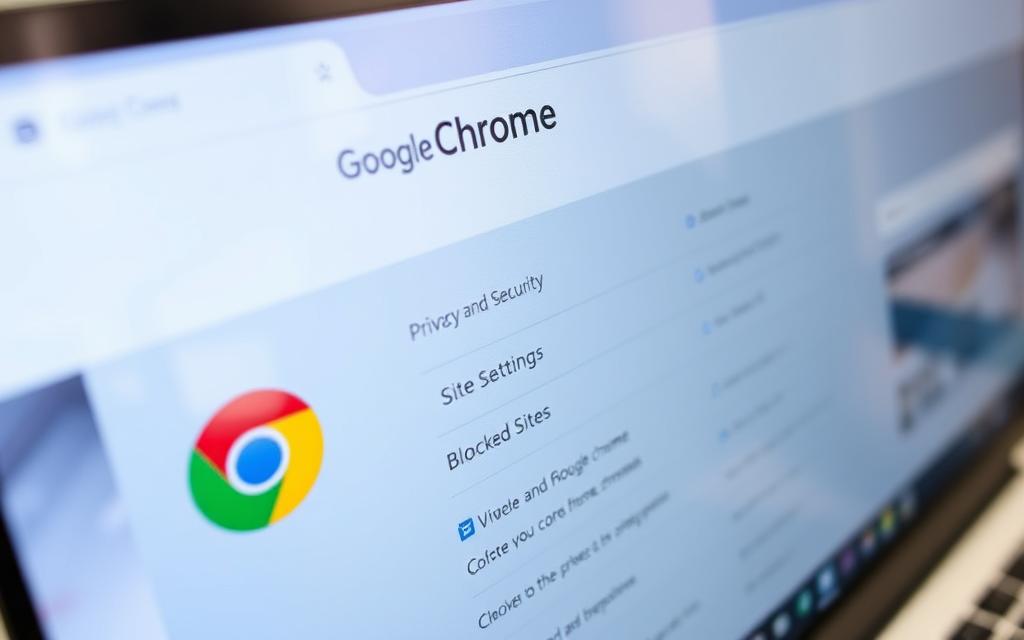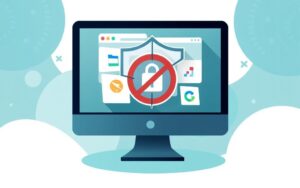Table of Contents
Blocked websites on Google Chrome can be annoying, especially on restricted networks. This guide offers methods to bypass restrictions and access blocked content safely. We’ll cover VPNs, proxy servers, Chrome settings, and other clever techniques.
Facing website restrictions at work, school, or due to censorship? Don’t worry. There are effective ways to regain access to the content you need.
Our guide explores strategies to unblock websites on Google Chrome for PC. You’ll learn how to browse freely and securely in no time.
Understanding Website Blocking in Chrome
Internet censorship and network restrictions can hinder access to certain websites on Google Chrome. Understanding the reasons, types, and impact of these limitations can help you navigate challenges more effectively.
Common Reasons for Website Restrictions
Website blocking often stems from school or workplace policies, government regulations, and security measures. These restrictions aim to boost productivity and protect against internet censorship.
They also help mitigate risks linked to content filtering and network security.
Types of Website Blocks
- IP-based blocking: Restricting access to websites by their IP addresses.
- DNS-based filtering: Preventing users from resolving website domain names to their corresponding IP addresses.
- Content-based filtering: Blocking access to websites based on their content, such as specific keywords, categories, or file types.
Impact of Network Restrictions
Network restrictions can greatly affect user experience and access to information. People may struggle to explore internet resources, hampering productivity, learning, and personal growth.
These firewall measures can also cause frustration and disconnect users from the digital world.
“Understanding the nature of website blocking is the first step towards regaining your online freedom and accessing the content you need.”
Knowing the factors behind website blocking helps users grasp their challenges better. This knowledge enables them to find effective solutions to overcome these obstacles.
Essential Preparations Before Unblocking Websites
Internet safety and cybersecurity are vital when unblocking websites. A thorough risk assessment is crucial before bypassing any restrictions. Understanding potential implications helps make informed decisions.
Check if accessing blocked content violates any terms or laws. Assess the need for restricted websites. Weigh the benefits against security risks carefully.
- Review your organisation’s network policies and the reasons behind the website restrictions.
- Familiarise yourself with the cybersecurity best practices to mitigate any risks associated with unblocking websites.
- Consult with your IT department or network administrators to understand the impact of your actions and obtain the necessary permissions, if required.
Understand the methods for unblocking websites, like VPNs or proxy servers. Evaluate these tools for stability, security, and reliability. This ensures safe and effective browsing.
| Consideration | Importance |
|---|---|
| Compliance with Network Policies | High |
| Cybersecurity Risk Assessment | High |
| Necessity of Accessing Blocked Content | Moderate |
| Understanding Unblocking Methods | High |
These essential preparations help reduce risks when unblocking websites. They ensure a secure and responsible browsing experience. Careful planning leads to safer internet use.
“Cybersecurity should be a top priority when accessing restricted websites. Careful planning and risk assessment are crucial steps to ensure a safe and compliant unblocking process.”
How to Unblock Websites on Chrome PC
Chrome’s website blocks can be frustrating. They may occur due to security concerns, network rules, or government policies. Luckily, there are ways to bypass these limits and access blocked content.
Checking Chrome Security Settings
Start by reviewing Chrome’s security settings. These may be blocking certain sites deemed risky. Go to Chrome’s settings menu and check the security options. Adjust the security level to suit your needs.
Consider allowing access to specific trusted sites. This can help you view content that was previously blocked.
Modifying Site Permissions
Chrome lets you manage permissions for individual websites. This includes access to location, camera, and microphone. Review and adjust these permissions as needed.
By granting necessary access, you can unblock previously restricted websites. This allows you to view the content you want.
Adjusting Chrome Privacy Settings
Chrome’s privacy settings can affect website access. Find a balance between security and accessibility. Look at options like incognito mode, cookie management, and content blocking.
Tweak these settings to access needed websites. Remember to maintain your online safety while doing so.
Explore Chrome’s settings, site permissions, and privacy configuration. This can help you unblock websites and access desired content. You’ll also keep necessary security options to protect your online experience.

Using VPN Solutions for Website Access
Virtual Private Networks (VPNs) are powerful tools for unblocking websites and bypassing geo-restrictions. They mask your IP address and encrypt internet traffic. This helps you access content that might be unavailable due to network restrictions or censorship.
When selecting a VPN service, look for providers with many server locations. This increases your chances of finding a server that can unblock the website you need. CyberGhost VPN, Browsec VPN, and TunnelBear VPN offer free server locations in various countries.
These VPNs also provide paid server networks for better IP address masking and geo-restriction bypass abilities.
| VPN Provider | Free Server Locations | Paid Server Locations | Ratings |
|---|---|---|---|
| CyberGhost VPN | Germany, Netherlands, Romania, United States | 58 countries, 4,800 servers | – |
| Browsec VPN | Netherlands, Singapore, United Kingdom, United States | 12 locations | – |
| TunnelBear VPN | All paid server locations | 20 countries | – |
| HotSpot Shield VPN | Germany, Russia, Canada, Netherlands | India, Singapore, UK, France, US | – |
| Windscribe VPN | US, Canada, France, Germany, Netherlands, Norway, Romania, Switzerland, Hong Kong, UK | Global server network | – |
| ExpressVPN | – | Global server network | 1K ratings |
ExpressVPN is a popular choice for a reliable and feature-rich VPN service. It offers fast unblocking abilities, effective IP address masking, and robust online privacy protection. ExpressVPN has a global network of servers and various pricing options.
This VPN is a versatile solution for accessing restricted websites and maintaining geo-restriction bypass activities.
“VPNs are essential for safeguarding online privacy and bypassing content restrictions. They provide a secure, encrypted connection to the internet, shielding your activities from prying eyes.”
Proxy Servers and Their Implementation
Web proxy servers are vital tools for bypassing website restrictions and boosting online privacy. They act as middlemen between your device and the internet. These servers mask your IP address and offer alternate routes for content access.
Different Types of Proxy Servers
Various proxy servers exist, each with unique abilities and uses. The most common types include:
- HTTP/HTTPS Proxies: These handle standard web traffic, hiding your IP address for extra anonymity.
- SOCKS Proxies: Operating at the network layer, these support more protocols like FTP and P2P.
Setting Up a Proxy in Chrome
Setting up a web proxy in Google Chrome is easy. Go to the browser’s settings and find the “Proxy settings” section. Then, manually enter the proxy server’s address and port number.
This setup routes your web traffic through the proxy. It effectively hides your IP address and enables anonymous browsing.
Benefits and Limitations
Proxy servers offer convenient solutions for IP address hiding and bypassing content restrictions. However, they often have slower speeds and less security than Virtual Private Networks (VPNs).
Proxies are usually free but don’t encrypt data like VPNs do. This leaves users open to potential man-in-the-middle attacks.
“Proxy servers enhance online privacy and access restricted content. However, use them carefully as they may not be as secure as advanced network intermediary solutions.”
Advanced Methods for Website Unblocking
Users facing persistent website blocks may need to explore advanced techniques. Virtual Private Networks (VPNs) and proxy servers are reliable, but additional methods can be effective. These include using the Tor browser, accessing websites via IP addresses, and switching between HTTP and HTTPS.
The Tor browser maintains online anonymity and bypasses censorship. It routes internet traffic through volunteer servers, obscuring the user’s IP address. This makes it hard for website blockers to restrict access.
Accessing a website by its IP address can bypass URL-based filtering. Switching between HTTP and HTTPS versions of a website can also help. Some blocks may only target the less secure HTTP protocol.
URL manipulation can be effective in certain cases. Services like URL shorteners and HTML-to-PDF converters can alter website addresses. This can help bypass IP address lookup or HTTPS bypass restrictions.
These methods, along with VPNs and proxies, offer a toolkit for navigating website blocking. Understanding these techniques helps users overcome various internet access challenges. They can adapt their approach to suit different situations.
Troubleshooting Common Unblocking Issues
Unblocking websites on Google Chrome can lead to error messages and performance issues. Let’s explore these problems and their solutions. This knowledge will help you browse smoothly and safely.
Error Messages and Solutions
SSL certificate issues often pop up when unblocking websites. This happens when Chrome doesn’t trust a site’s security certificate. Try bypassing the SSL error or updating Chrome to fix this.
Network diagnostic errors like “DNS_PROBE_FINISHED_NXDOMAIN” are also common. These can stem from DNS problems or internet connection issues. To solve these, try changing DNS settings or checking your network connection.
Performance Considerations
Some unblocking methods, like VPNs, can slow down your browsing. This is due to added encryption and routing. Choose a trustworthy VPN provider with fast servers to minimise speed issues.
Security Implications
Unblocking websites can open doors to restricted content. However, it’s vital to consider the security risks. Untested proxy servers or VPNs might expose your device to malware.
It’s recommended to regularly update your chosen unblocking tools to maintain their effectiveness and security. This helps keep your online activities safe and efficient.
Conclusion
Unrestricted website access is crucial for digital rights and online freedom. This article has outlined effective ways to overcome website blocking on Google Chrome for PC.
Users have various tools to bypass restrictions. These include adjusting browser settings, using VPNs, and employing proxy servers. It’s vital to prioritise online safety and follow legal guidelines when unblocking websites.
Understanding why websites are blocked helps users choose suitable unblocking methods. Common reasons include security concerns, censorship, and content restrictions.
The freedom to access online content is a fundamental right. The strategies in this guide empower users to reclaim this right responsibly.
FAQ
What are the common reasons for website restrictions?
Website blocking happens for various reasons. These include school or workplace policies, government rules, and security measures. Blocks can be IP-based, DNS-based, or content-based.
How do network restrictions impact users?
Network restrictions can limit access to information and affect productivity. They may also impact user experience. Understanding these effects is key to unblocking websites effectively.
What should I consider before attempting to unblock websites?
Before unblocking websites, think about the risks and consequences. Make sure you’re not breaking any rules or laws. Ask yourself if you really need to access the blocked content.
Also, be aware of the security risks involved. It’s important to stay safe online.
How can I unblock websites by adjusting Chrome settings?
You can unblock websites by tweaking Chrome settings. Check your security settings and change site permissions. Adjust privacy settings as needed.
You can also access Chrome’s advanced settings. This allows you to manage content permissions more closely.
How can I use VPNs to unblock websites on Chrome?
VPNs are great for unblocking websites. They hide your IP address and encrypt your internet traffic. Choose a trustworthy VPN service.
Download the VPN app or browser extension. Sign in and connect to a server. You should then be able to access blocked sites.
What are the different types of proxy servers and how can I set them up in Chrome?
Proxy servers act as go-betweens for your device and the internet. They can help you bypass website blocks by hiding your IP address. Types include HTTP, HTTPS, and SOCKS proxies.
To set up a proxy in Chrome, go to the browser’s settings. Look for the network or proxy settings section.
What are some advanced methods for unblocking websites?
There are several advanced ways to unblock websites. You can use the Tor browser for anonymity. Try accessing websites via their IP addresses instead of domain names.
Switching between HTTP and HTTPS protocols can sometimes work. URL shorteners may also help you bypass some blocks.
How can I troubleshoot common unblocking issues?
To fix unblocking problems, understand error messages and their solutions. Be aware that some methods, like VPNs, might slow down your connection.
Remember the security risks too. You might expose yourself to harmful content. You could also break network rules.









